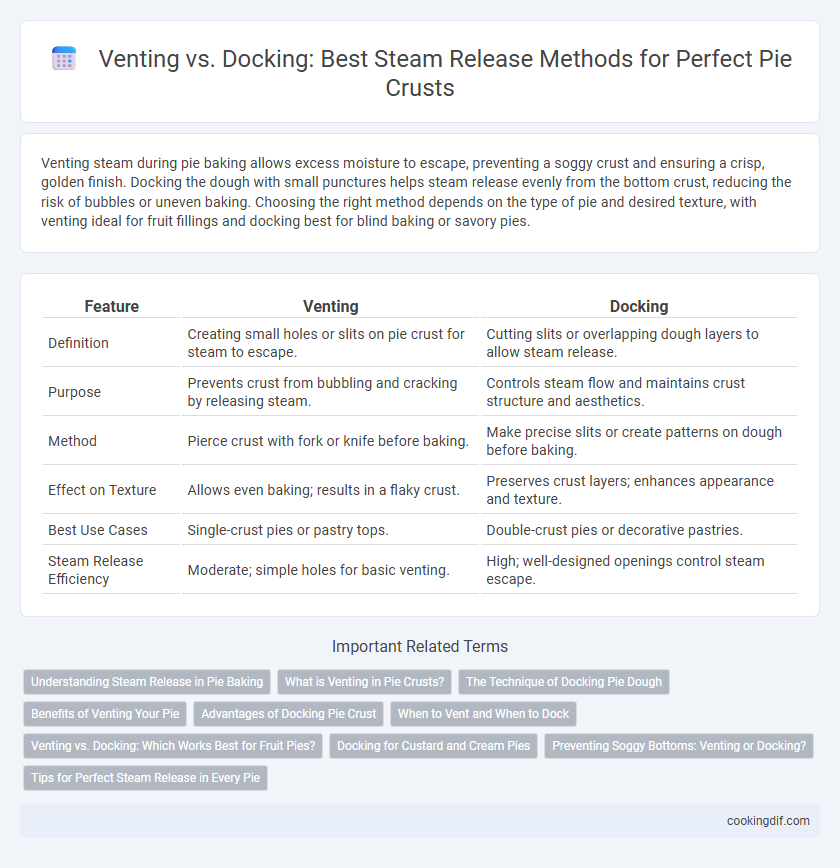Venting steam during pie baking allows excess moisture to escape, preventing a soggy crust and ensuring a crisp, golden finish. Docking the dough with small punctures helps steam release evenly from the bottom crust, reducing the risk of bubbles or uneven baking. Choosing the right method depends on the type of pie and desired texture, with venting ideal for fruit fillings and docking best for blind baking or savory pies.
Table of Comparison
| Feature | Venting | Docking |
|---|---|---|
| Definition | Creating small holes or slits on pie crust for steam to escape. | Cutting slits or overlapping dough layers to allow steam release. |
| Purpose | Prevents crust from bubbling and cracking by releasing steam. | Controls steam flow and maintains crust structure and aesthetics. |
| Method | Pierce crust with fork or knife before baking. | Make precise slits or create patterns on dough before baking. |
| Effect on Texture | Allows even baking; results in a flaky crust. | Preserves crust layers; enhances appearance and texture. |
| Best Use Cases | Single-crust pies or pastry tops. | Double-crust pies or decorative pastries. |
| Steam Release Efficiency | Moderate; simple holes for basic venting. | High; well-designed openings control steam escape. |
Understanding Steam Release in Pie Baking
Venting in pie baking involves creating small cuts or holes in the pie crust to allow steam to escape, preventing the filling from becoming soggy and the crust from bursting. Docking refers to pricking the dough with a fork before baking, which controls steam release and ensures even cooking by preventing large air bubbles. Proper steam release techniques, including venting and docking, are crucial for maintaining the pie's structural integrity and achieving a crisp, golden crust.
What is Venting in Pie Crusts?
Venting in pie crusts involves creating small slits or holes in the top crust to allow steam to escape during baking, preventing sogginess and ensuring a crisp texture. This technique helps maintain the pie's structural integrity by reducing the risk of bubbling or cracking caused by trapped steam. Proper venting is essential for fruit pies or fillings with high moisture content to achieve an evenly cooked, golden-brown crust.
The Technique of Docking Pie Dough
Docking pie dough involves pricking it with a fork or specialized tool before baking to allow steam to escape evenly, preventing bubbles and ensuring a flat, crisp crust. This technique is essential for blind baking, as venting through docking controls moisture release without disrupting the dough's surface. Proper docking improves texture and baking consistency compared to relying solely on vent cuts or slits, making it a preferred method for smooth, stable pie crusts.
Benefits of Venting Your Pie
Venting your pie during baking allows steam to escape, preventing soggy crusts and maintaining a crisp, flaky texture. Proper steam release reduces the risk of pie filling bubbling over, ensuring a cleaner presentation and even cooking. The technique enhances overall flavor by preserving the pie's structural integrity and preventing excess moisture buildup.
Advantages of Docking Pie Crust
Docking pie crust involves creating small, evenly spaced holes in the dough, allowing steam to escape uniformly and preventing unsightly bubbles during baking. This technique promotes even cooking by enabling moisture to evaporate effectively, resulting in a crisp, flaky crust. Unlike venting, docking eliminates the need for slits or cuts that can compromise the pie's visual appeal and structural integrity.
When to Vent and When to Dock
Venting pie crusts during baking allows steam to escape, preventing sogginess and ensuring a crisp, flaky top, especially important for fruit-filled pies with high moisture content. Docking, or pricking the crust with a fork, is ideal for pre-baked shells or pies with less filling moisture to avoid puffing and ensure even baking. Choosing venting versus docking depends largely on the moisture level of the filling: vent for juicy, steam-producing fillings and dock for drier or pre-baked pastry.
Venting vs. Docking: Which Works Best for Fruit Pies?
Venting fruit pies allows steam to escape, preventing soggy crusts and ensuring a crisp, golden finish, especially with juicy fillings like apple or cherry. Docking, which involves pricking small holes in the crust, can help control steam release but may not be as effective in preventing bubbling or filling overflow during baking. For fruit pies, venting with strategic slits usually provides better steam management and enhances overall texture and appearance.
Docking for Custard and Cream Pies
Docking custard and cream pies before baking allows steam to escape evenly, preventing bubble formation and crust cracking. This technique creates small holes in the dough, ensuring a smooth and stable surface essential for delicate fillings. Proper docking preserves the pie's texture and appearance by maintaining structural integrity during steam release.
Preventing Soggy Bottoms: Venting or Docking?
Venting and docking are two key techniques for preventing soggy bottoms in pies by ensuring steam escapes during baking. Venting involves cutting slits or shapes in the pie crust, allowing moisture to escape and the filling to cook properly without soaking the crust. Docking, which means piercing the pie dough with a fork before baking, creates small holes that help steam release evenly, reducing the risk of a wet, undercooked bottom crust.
Tips for Perfect Steam Release in Every Pie
Proper venting in pie crusts allows steam to escape during baking, preventing soggy fillings and ensuring a crisp, golden crust. Docking the dough with small punctures distributes steam evenly, reducing the risk of bubbles and uneven cooking. Combine venting and docking techniques to achieve consistent steam release, resulting in perfectly baked pies with balanced texture and flavor.
Venting vs docking for steam release Infographic

 cookingdif.com
cookingdif.com